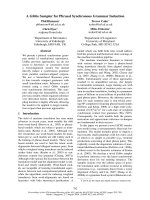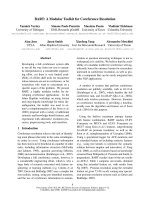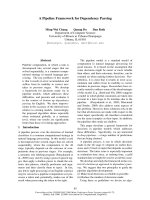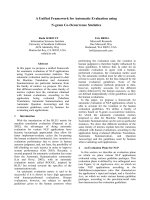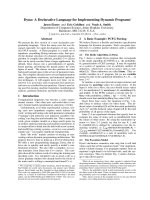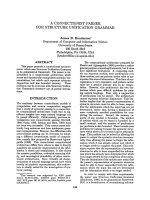Báo cáo khoa học: "A Multi-resolution Framework for Information Extraction from Free Text" pptx
Bạn đang xem bản rút gọn của tài liệu. Xem và tải ngay bản đầy đủ của tài liệu tại đây (153.69 KB, 8 trang )
Proceedings of the 45th Annual Meeting of the Association of Computational Linguistics, pages 592–599,
Prague, Czech Republic, June 2007.
c
2007 Association for Computational Linguistics
A Multi-resolution Framework for Information Extraction from Free Text
Mstislav Maslennikov and Tat-Seng Chua
Department of Computer Science
National University of Singapore
{maslenni,chuats}@comp.nus.edu.sg
Abstract
Extraction of relations between entities is
an important part of Information Extraction
on free text. Previous methods are mostly
based on statistical correlation and depend-
ency relations between entities. This paper
re-examines the problem at the multi-
resolution layers of phrase, clause and sen-
tence using dependency and discourse rela-
tions. Our multi-resolution framework
ARE (Anchor and Relation) uses clausal
relations in 2 ways: 1) to filter noisy de-
pendency paths; and 2) to increase reliabil-
ity of dependency path extraction. The re-
sulting system outperforms the previous
approaches by 3%, 7%, 4% on MUC4,
MUC6 and ACE RDC domains respec-
tively.
1 Introduction
Information Extraction (IE) is the task of identify-
ing information in texts and converting it into a
predefined format. The possible types of informa-
tion include entities, relations or events. In this
paper, we follow the IE tasks as defined by the
conferences MUC4, MUC6 and ACE RDC: slot-
based extraction, template filling and relation ex-
traction, respectively.
Previous approaches to IE relied on co-
occurrence (Xiao et al., 2004) and dependency
(Zhang et al., 2006) relations between entities.
These relations enable us to make reliable extrac-
tion of correct entities/relations at the level of a
single clause. However, Maslennikov et al. (2006)
reported that the increase of relation path length
will lead to considerable decrease in performance.
In most cases, this decrease in performance occurs
because entities may belong to different clauses.
Since clauses in a sentence are connected by
clausal relations (Halliday and Hasan, 1976), it is
thus important to perform discourse analysis of a
sentence.
Discourse analysis may contribute to IE in sev-
eral ways. First, Taboada and Mann (2005) re-
ported that discourse analysis helps to decompose
long sentences into clauses. Therefore, it helps to
distinguish relevant clauses from non-relevant
ones. Second, Miltsakaki (2003) stated that entities
in subordinate clauses are less salient. Third, the
knowledge of textual structure helps to interpret
the meaning of entities in a text (Grosz and Sidner
1986). As an example, consider the sentences
“ABC Co. appointed a new chairman. Addition-
ally, the current CEO was retired”. The word ‘ad-
ditionally’ connects the event in the second sen-
tence to the entity ‘ABC Co.’ in the first sentence.
Fourth, Moens and De Busser (2002) reported that
discourse segments tend to be in a fixed order for
structured texts such as court decisions or news.
Hence, analysis of discourse order may reduce the
variability of possible relations between entities.
To model these factors, we propose a multi-
resolution framework ARE that integrates both
discourse and dependency relations at 2 levels.
ARE aims to filter noisy dependency relations
from training and support their evaluation with
discourse relations between entities. Additionally,
we encode semantic roles of entities in order to
utilize semantic relations. Evaluations on MUC4,
MUC6 and ACE RDC 2003 corpora demonstrates
that our approach outperforms the state-of-art sys-
tems mainly due to modeling of discourse rela-
tions.
The contribution of this paper is in applying dis-
course relations to supplement dependency rela-
tions in a multi-resolution framework for IE. The
592
framework enables us to connect entities in differ-
ent clauses and thus improve the performance on
long-distance dependency paths.
Section 2 describes related work, while Section
3 presents our proposed framework, including the
extraction of anchor cues and various types of rela-
tions, integration of extracted relations, and com-
plexity classification. Section 4 describes our ex-
perimental results, with the analysis of results in
Section 5. Section 6 concludes the paper.
2 Related work
Recent work in IE focuses on relation-based, se-
mantic parsing-based and discourse-based ap-
proaches. Several recent research efforts were
based on modeling relations between entities. Cu-
lotta and Sorensen (2004) extracted relationships
using dependency-based kernel trees in Support
Vector Machines (SVM). They achieved an F
1
-
measure of 63% in relation detection. The authors
reported that the primary source of mistakes comes
from the heterogeneous nature of non-relation in-
stances. One possible direction to tackle this prob-
lem is to carry out further relationship classifica-
tion. Maslennikov et al. (2006) classified relation
path between candidate entities into simple, aver-
age and hard cases. This classification is based on
the length of connecting path in dependency parse
tree. They reported that dependency relations are
not reliable for the hard cases, which, in our opin-
ion, need the extraction of discourse relations to
supplement dependency relation paths.
Surdeanu et al. (2003) applied semantic parsing
to capture the predicate-argument sentence struc-
ture. They suggested that semantic parsing is use-
ful to capture verb arguments, which may be con-
nected by long-distance dependency paths. How-
ever, current semantic parsers such as the ASSERT
are not able to recognize support verb construc-
tions such as “X conducted an attack on Y” under
the verb frame “attack” (Pradhan et al. 2004).
Hence, many useful predicate-argument structures
will be missed. Moreover, semantic parsing be-
longs to the intra-clausal level of sentence analysis,
which, as in the dependency case, will need the
support of discourse analysis to bridge inter-clausal
relations.
Webber et al. (2002) reported that discourse
structure helps to extract anaphoric relations. How-
ever, their set of grammatical rules is heuristic. Our
task needs construction of an automated approach
to be portable across several domains. Cimiano et
al. (2005) employed a discourse-based analysis for
IE. However, their approach requires a predefined
domain-dependent ontology in the format of ex-
tended logical description grammar as described by
Cimiano and Reely (2003). Moreover, they used
discourse relations between events, whereas in our
approach, discourse relations connect entities.
3 Motivation for using discourse relations
Our method is based on Rhetorical Structure The-
ory (RST) by Taboada and Mann (2005). RST
splits the texts into 2 parts: a) nuclei, the most im-
portant parts of texts; and b) satellites, the secon-
dary parts. We can often remove satellites without
losing the meaning of text. Both nuclei and satel-
lites are connected with discourse relations in a
hierarchical structure. In our work, we use 16
classes of discourse relations between clauses: At-
tribution, Background, Cause, Comparison, Condi-
tion, Contrast, Elaboration, Enablement, Evalua-
tion, Explanation, Joint, Manner-Means, Topic-
Comment, Summary, Temporal, Topic-Change.
The additional 3 relations impose a tree structure:
textual-organization, span and same-unit. All the
discourse relation classes are potentially useful,
since they encode some knowledge about textual
structure. Therefore, we decide to include all of
them in the learning process to learn patterns with
best possible performance.
We consider two main rationales for utilizing
discourse relations to IE. First, discourse relations
help to narrow down the search space to the level
of a single clause. For example, the sentence
“[<Soc-A1>Trudeau
</>'s <Soc-A2>son</> told
everyone], [their prime minister
was his father],
[who took him
to a secret base in the arctic] [and
let him
peek through a window].” contains 4
clauses and 7 anchor cues (key phrases) for the
type Social, which leads to 21 possible variants.
Splitting this sentence into clauses reduces the
combinations to 4 possible variants. Additionally,
this reduction eliminates the long and noisy de-
pendency paths.
Second, discourse analysis enables us to connect
entities in different clauses with clausal relations.
As an example, we consider a sentence “It’s a dark
comedy about a boy named <AT-A1>Marshal</>
played by Amourie Kats who discovers all kinds of
593
on and scary things going on in <AT-A2>a seem-
ingly quiet little town</>”. In this example, we
need to extract the relation “At” between the enti-
ties “Marshal” and “a seemingly quiet little town”.
The discourse structure of this sentence is given in
.Figure 1
Figure 1. Example of discourse parsing
The discourse path “Marshal <-elaboration- _
<-span- _ -elaboration-> _ -elaboration-> town”
is relatively short and captures the necessary rela-
tions. At the same time, prediction based on de-
pendency path “Marshal <–obj- _ <-i- _ <-fc- _
<-pnmod- _ <-pred- _ <-i- _ <-null- _ -null-> _ -
rel-> _ -i-> _ -mod-> _ -pcomp-n-> town” is un-
reliable, since the relation path is long. Thus, it is
important to rely on discourse analysis in this ex-
ample. In addition, we need to evaluate both the
score and reliability of prediction by relation path
of each type.
4 Anchors and Relations
In this section, we define the key components that
we use in ARE: anchors, relation types and general
architecture of our system. Some of these compo-
nents are also presented in detail in our previous
work (Maslennikov et al., 2006).
4.1 Anchors
The first task in IE is to identify candidate phrases
(which we call anchor or anchor cue) of a pre-
defined type
(anchor type) to fill a desired slot in
an
IE template. The example anchor for the phrase
“Marshal” is shown in Figure 2.
Given a training set of sentences,
we extract the anchor cues A
Cj
=
[A
1
, …, A
Nanch
] of type C
j
using
the procedures described in
Maslennikov et al. (2006). The
linguistic features of these an-
chors
for the anchor types of Per-
petrator, Action, Victim and Target for the MUC4
domain are given in Table 1.
Anchor
types
Feature
Perpetrator_Cue
(A)
Action_Cue
(D)
Victim_Cue
(A)
Target_Cue
(A)
Lexical
(Head noun)
terrorists,
individuals,
Soldiers
attacked,
murder,
Massacre
Mayor,
general,
priests
bridge,
house,
Ministry
Part-of-Speech Noun Verb Noun Noun
Named Enti-
ties
Soldiers
(PERSON)
- Jesuit priests
(PERSON)
WTC
(OBJECT)
Synonyms Synset 130, 166 Synset 22 Synset 68 Synset 71
Concept Class ID 2, 3 ID 9 ID 22, 43 ID 61, 48
Co-referenced
entity
He -> terrorist,
soldier
- They ->
peasants
-
Clausal type Nucleus
Satellite
Nucleus,
Satellite
Nucleus,
Satellite
Nucleus,
Satellite
Argument type Arg
0
, Arg
1
Roo
t
Target, -,
ArgM-MNR
Arg
0
,
Arg
1
Arg
1
, ArgM-
MNR
Table 1. Linguistic features for anchor extraction
Given an input phrase P from a test sentence, we
need to classify if the phrase belongs to anchor cue
type C
j
. We calculate the entity score as:
Entity_Score(P) =
∑
δ
i
* Feature_Score
i
(P,C
j
)
(1)
where Feature_Score(P,C
j
) is a score function for
a particular linguistic feature representation of type
C
j
, and δ
i
is the corresponding weight for that rep-
resentation in the overall entity score. The weights
are learned automatically using Expectation Maxi-
mization (Dempster et al., 1977). The Fea-
ture_Score
i
(P,C
j
) is estimated from the training set
as the number of slots containing the correct fea-
ture representation type versus all the slots:
Feature_Score
i
(P,C
j
) = #(positive slots) / #(all slots) (2)
We classify the phrase P as belonging to an anchor
type C
j
when its Entity_score(P) is above an em-
pirically determined threshold ω. We refer to this
anchor as A
j
. We allow a phrase to belong to mul-
tiple anchor types and hence the anchors alone are
not enough for filling templates.
4.2 Relations
To resolve the correct filling of phrase P of type C
i
in a desired slot in the template, we need to con-
sider the relations between multiple candidate
phrases of related slots. To do so, we consider sev-
eral types of relations between anchors: discourse,
dependency and semantic relations. These relations
capture the interactions between anchors and are
therefore useful for tackling the paraphrasing and
alignment problems (Maslennikov et al., 2006).
Given 2 anchors A
i
and A
j
of anchor types C
i
and
C
j
, we consider a relation Path
l
= [A
i
, Rel
1
,…,
Rel
n
, A
j
] between them, such that there are no an-
chors between A
i
and A
j
. Additionally, we assume
that the relations between anchors are represented
in the form of a tree T
l
, where l = {s, c, d} refers to
Satellite
who discovers all kinds of on and
scary things going on in a seem-
ingly quiet little town.
Nucleus
It's a dark
comedy
about a boy
Satellite
named Mar-
shal
Nucleus
played by
Amourie Kats
Nucleus
Satellite
span
elaboration
span
elaboration elaboration
span
Figure 2. Exam-
ple of anchor
Anchor A
i
Marshal
pos_NNP
list_personWord
Cand_AtArg1
Minipar_obj
Arg2
Spade_Satellite
594
discourse, dependency and semantic relation types
respectively. We describe the nodes and edges of
T
l
separately for each type, because their represen-
tations are different:
1) The nodes of discourse tree T
c
consist of clauses
[Clause
1
, …, Clause
Ncl
]; and their relation edges
are obtained from the Spade system described in
Soricut and Marcu (2003). This system performs
RST-based parsing at the sentence level. The re-
ported accuracy of Spade is 49% on the RST-DT
corpus. To obtain a clausal path, we map each
anchor A
i
to its clause in Spade. If anchors A
i
and A
j
belong to the same clause, we assign
them the relation same-clause.
es.
2) The nodes of dependency tree T
d
consist of
words in sentences; and their relation edges are
obtained from Minipar by Lin (1997). Lin
(1997) reported a parsing performance of Preci-
sion = 88.5% and Recall = 78.6% on the SU-
SANNE corpus.
3) The nodes of semantic tree T
s
consist of argu-
ments [Arg
0
, …, Arg
Narg
] and targets [Target
1
,
…, Target
Ntarg
]. Both arguments and targets are
obtained from the ASSERT parser developed by
Pradhan (2004). The reported performance of
ASSERT is F
1
=83.8% on the identification and
classification task for all arguments, evaluated
using PropBank and AQUAINT as the training
and testing corpora, respectively. Since the rela-
tion edges have a form Target
k
-> Arg
l
, the rela-
tion path in semantic frame contains only a sin-
gle relation. Therefore, we encode semantic rela-
tions as part of the anchor features.
In later parts of this paper, we consider only dis-
course and dependency relation paths Path
l
, where
l={c, d}.
Figure 3. Architecture of the system
4.3 Architecture of ARE system
In order to perform IE, it is important to extract
candidate entities (anchors) of appropriate anchor
types, evaluate the relationships between them,
further evaluate all possible candidate templates,
and output the final template. For the case of rela-
tion extraction task, the final templates are the
same as an extracted binary relation. The overall
architecture of ARE is given in Figure 3.
The focus of this paper is in applying discourse
relations for binary relationship evaluation.
5 Overall approach
In this section, we describe our relation-based ap-
proach to IE. We start with the evaluation of rela-
tion paths (single relation ranking, relation path
ranking) to assess the suitability of their anchors as
entities to template slots. Here we want to evaluate
given a single relation or relation path, whether the
two anchors are correct in filling the appropriate
slots in a template. This is followed by the integra-
tion of relation paths and evaluation of templates.
5.1 Evaluation of relation path
In the first stage, we evaluate from training data
the relevance of relation path Path
l
= [A
i
, Rel
1
,…,
Rel
n
, A
j
] between candidate anchors A
i
and A
j
of
types C
i
and C
j
. We divide this task into 2 steps.
The first step ranks each single relation Rel
k
∈
Path
l
; while the second step combines the evalua-
tions of Rel
k
to rank the whole relation path Path
l
.
Single relation ranking
Let Set
i
and Set
j
be the set of linguistic features of
anchors A
i
and A
j
respectively. To evaluate Rel
k
,
we consider 2 characteristics: (1) the direction of
relation Rel
k
as encoded in the tree structure; and
(2) the linguistic features, Set
i
and Set
j
, of anchors
A
i
and A
j
. We need to construct multiple single
relation classifiers, one for each anchor pair of
types C
i
and C
j
, to evaluate the relevance of Rel
k
with respect to these 2 anchor typ
Preprocessing
Corpus
(a) Construction of classifiers. The training data
to each classifier consists of anchor pairs of types
C
i
and C
j
extracted from the training corpus. We
use these anchor pairs to construct each classifier
in four stages. First, we compose the set of possi-
ble patterns in the form P
+
= { P
m
= <S
i
–Rel->
S
j
> | S
i
∈
Set
i
, S
j
∈
Set
j
}. The construction of P
m
Anchor
evaluation
Tem
p
lates
Anchor NEs
Template
evaluation
Sentences
Binary relationship
evaluation
Candidate
templates
595
conforms to the 2 characteristics given above.
Figure 4 illustrates several discourse and depend-
ency patterns of P
+
constructed from a sample sen-
tence.
Figure 4. Examples of discourse and dependency patterns
Second, we identify the candidate anchor A,
whose type matches slot C in a template. Third, we
find the correct patterns for the following 2 cases:
1) A
i
, A
j
are of correct anchor types; and 2) A
i
is an
action anchor, while A
j
is a correct anchor. Any
other patterns are considered as incorrect. We note
that the discourse and dependency paths between
anchors A
i
and A
j
are either correct or wrong si-
multaneously.
Fourth, we evaluate the relevance of each pat-
tern P
m
∈
P
+
. Given the training set, let PairSet
m
be the set of anchor pairs extracted by P
m
; and
PairSet
+
(C
i
, C
j
) be the set of correct anchor pairs
of types C
i
, C
j
. We evaluate both precision and
recall of P
m
as
||||
|),(||
)(
m
jim
m
PairSet
CCPairsSetPairSet
PrecisionP
|
=
+
Ι
(3)
||),(||
|),(||
)(
ji
jim
m
CCPairsSet
CCPairsSetPairSet
PecallR
+
+
|
=
Ι
(4)
These values are stored and used in the training
model for use during testing.
(b) Evaluation of relation. Here we want to
evaluate whether relation InputRel belongs to a
path between anchors InputA
i
and InputA
j
. We
employ the constructed classifier for the anchor
types InputC
i
and InputC
j
in 2 stages. First, we
find a subset P
(0)
= { P
m
= <S
i
–InputRel-> S
j
>
∈
P
+
| S
i
∈
InputSet
i
, S
j
∈
InputSet
j
} of applicable
patterns. Second, we utilize P
(0)
to find the pattern
P
m
(0)
with maximal precision:
Precision(P
m
(0)
) = argmax
Pm
∈
P(0)
Precision (P
m
)
(5)
A problem arises if P
m
(0)
is evaluated only on a
small amount of training instances. For example,
we noticed that patterns that cover 1 or 2 instances
may lead to Precision=1, whereas on the testing
corpus their accuracy becomes less than 50%.
Therefore, it is important to additionally consider
the recall parameter of P
m
(0)
.
Relation path ranking
In this section, we want to evaluate relation path
connecting template slots C
i
and C
j
. We do this
independently for each relation of type discourse
and dependency. Let Recall
k
and Precision
k
be the
recall and precision values of Rel
k
in Path = [A
i
,
Rel
1
,…, Rel
n
, A
j
], both obtained from the previous
step. First, we calculate the average recall of the
involved relations:
W = (1/Length
Path
) *
∑
Relk
∈
Path
Recall
k
(6)
W gives the average recall of the involved rela-
tions and can be used as a measure of reliability of
the relation Path. Next, we compute a combined
score of average Precision
k
weighted by Recall
k
:
Score = 1/(W*Length
Path
)*
∑
Relk
∈
Path
Recall
k
*Precision
k
(7)
We use all Precision
k
values in the path here, be-
cause omitting a single relation may turn a correct
path into the wrong one, or vice versa. The com-
bined score value is used as a ranking of the rela-
tion path. Experiments show that we need to give
priority to scores with higher reliability W. Hence
we use (W, Score) to evaluate each Path.
5.2 Integration of different relation path
types
The purpose of this stage is to integrate the evalua-
tions for different types of relation paths. The input
to this stage consists of evaluated relation paths
Path
C
and Path
D
for discourse and dependency
relations respectively. Let (W
l
, Score
l
) be an
evaluation for Path
l
, l
∈
[c, d]. We first define an
integral path Path
I
between A
i
and A
j
as: 1) Path
I
is enabled if at least one of Path
l
, l
∈
[c, d], is en-
abled; and 2) Path
I
is correct if at least one of
Path
l
is correct. To evaluate Path
I
, we consider the
average recall W
l
of each Path
l
, because W
l
esti-
elaboration
obj
Anchor A
j
town
pos_NN
Cand_AtArg2
Minipar_pcompn
ArgM-Loc
Spade_Satellite
Anchor A
i
Marshal
pos_NNP
list_personWord
Cand_AtArg1
Minipar_obj
Arg2
S
p
ade Satellite
pcomp-n
fc
span
D
iscourse
p
ath
D
e
p
endenc
y
p
ath
i
elaboration
Input sentence
Marshal… named <At-A1> </> played by Amourie Kats who discovers all kinds
of on and scary things going on in <At-A2>
Dependency patterns
Minipar_obj <–i- ArgM-Loc
Minipar_obj <–obj- ArgM-Loc
Minipar_obj –pcompn-> Minipar_pcompn
Minipar_obj –mod-> Minipar_pcompn
…
a seemingly quiet little town</>
elaboration
pnmod
pred
i
null
null
rel
i
mo
d
Discourse patterns
list_personWord <–elaboration- pos_NN
list_personWord –elaboration-> town
list_personWord <–span- town
list_personWord <–elaboration- town
…
596
mates the reliability of Score
l
. We define a
weighted average for Path
l
as:
W
I
= W
C
+ W
D
(8)
Score
I
= 1/W
I
*
∑
l
W
l
*Score
l
(9)
Next, we want to determine the threshold score
Score
I
O
above which Score
I
is acceptable. This
score may be found by analyzing the integral paths
on the training corpus. Let S
I
= { Path
I
} be the set
of integral paths between anchors A
i
and A
j
on the
training set. Among the paths in S
I
, we need to de-
fine a set function S
I
(X) = { Path
I
| Score
I
(Path
I
)
≥
X } and find the optimal threshold for X. We find
the optimal threshold based on F
1
-measure, be-
cause precision and recall are equally important in
IE. Let S
I
(X)
+
⊂ S
I
(X) and S(X)
+
⊂ S(X) be sets of
correct path extractions. Let F
I
(X) be F
1
-measure
of S
I
(X):
||)(||
||)(||
)(
XS
XS
XP
I
I
I
+
=
(10)
||)(||
||)(||
)(
+
+
=
XS
XS
XR
I
I
(11)
)()(
)(*)(*2
)(
XRXP
XRXP
XF
II
II
I
+
=
(12)
Based on the computed values F
I
(X) for each X on
the training data, we determine the optimal thresh-
old as Score = argmax F (X)
I
O
X I
, which corre-
sponds to the maximal expected F
1
-measure of
anchor pair A
i
and A
j
.
5.3 Evaluation of templates
At this stage, we have a set of accepted integral
relation paths between any anchor pair A
i
and A
j
.
The next task is to merge appropriate set of an-
chors into candidate templates. Here we follow the
methodology of Maslennikov et al. (2006). For
each sentence, we compose a set of candidate tem-
plates T using the extracted relation paths between
each A
i
and A
j
. To evaluate each template T
i
∈
T,
we combine the integral scores from relation paths
between its anchors A
i
and A
j
into the overall Rela-
tion_Score
T
:
M
AAScore
TScoreelationR
Kji
jiI
iT
∑
≤≤
=
,1
),(
)(_
(13)
where K is the number of extracted slots, M is the
number of extracted relation paths between an-
chors A
i
and A
j
, and Score
I
(A
i
, A
j
) is obtained
from Equation (9).
Next, we calculate the extracted entity score
based on the scores of all the anchors in T
i
:
∑
≤≤
=
Kk
kiT
KAScoreEntityTScoreEntity
1
/)(_)(_
(14)
where Entity_Score(A
i
) is taken from Equation (1).
Finally, we obtain the combined evaluation for a
template:
Score
T
(T
i
) = (1-
λ
) * Entity_Score
T
(T
i
) +
λ
* Relation_Score
T
(T
i
)
(15)
where λ is a predefined constant.
In order to decide whether the template T
i
should be accepted or rejected, we need to deter-
mine a threshold Score
T
O
from the training data. If
anchors of a candidate template match slots in a
correct template, we consider the candidate tem-
plate as correct. Let TrainT = { T
i
} be the set of
candidate templates extracted from the training
data, TrainT
+
⊂ TrainT be the subset of correct
candidate templates, and TotalT
+
be the total set of
correct templates in the training data. Also, let
TrainT(X) = { T
i
| Score
T
(T
i
)
≥
X, T
i
∈
TrainT } be
the set of candidate templates with score above X
and TrainT
+
(X) ⊂ TrainT(X) be the subset of cor-
rect candidate templates. We define the measures
of precision, recall and F
1
as follows:
||)(||
||)(||
)(
XTrainT
XTrainT
XP
T
+
=
(16)
||||
||)(||
)(
+
+
=
TotalT
XTrainT
XR
T (17)
)()(
)()(*2
)(
XRXP
XRXP
XF
TT
TT
T
+
=
(18)
Since the performance in IE is measured in F
1
-
measure, an appropriate threshold to be used for
the most prominent candidate templates is:
Score
T
O
= argmax
X
F
T
(X) (19)
The value Score
T
O
is used as a training model.
During testing, we accept a candidate template In-
putT
i
if Score
T
(InputT
i
) > Sco
O
re .
T
As an additional remark, we note that domains
MUC4, MUC6 and ACE RDC 2003 are signifi-
cantly different in the evaluation methodology for
the candidate templates. While the performance of
the MUC4 domain is measured for each slot indi-
vidually; the MUC6 task measures the perform-
ance on the extracted templates; and the ACE RDC
2003 task evaluates performance on the matching
relations. To overcome these differences, we con-
struct candidate templates for all the domains and
measure the required type of performance for each
domain. Our candidate templates for the ACE
RDC 2003 task consist of only 2 slots, which cor-
respond to entities of the correct relations.
597
6 Experimental results
We carry out our experiments on 3 domains:
MUC4 (Terrorism), MUC6 (Management Succes-
sion), and ACE-Relation Detection and Characteri-
zation (2003). The MUC4 corpus contains 1,300
documents as training set and 200 documents
(TST3 and TST4) as official testing set. We used a
modified version of the MUC6 corpus described
by Soderland (1999). This version includes 599
documents as training set and 100 documents as
testing set. Following the methodology of Zhang et
al. (2006), we use only the English portion of ACE
RDC 2003 training data. We used 97 documents
for testing and the remaining 155 documents for
training. Our task is to extract 5 major relation
types and 24 subtypes.
Case (%) P R F
1
GRID 52% 62% 57%
Riloff’05 46% 51% 48%
ARE (2006) 58% 61% 60%
ARE 65% 61% 63%
Table 2. Results on MUC4
To compare the results on the terrorism domain
in MUC4, we choose the recent state-of-art sys-
tems GRID by Xiao et al. (2004), Riloff et al.
(2005) and ARE (2006) by Maslennikov et al.
(2006) which does not utilize discourse and seman-
tic relations. The comparative results are given in
Table 2. It shows that our enhanced ARE results in
3% improvement in F
1
measure over ARE (2006)
that does not use clausal relations. The improve-
ment was due to the use of discourse relations on
long paths, such as “X
distributed leaflets claiming
responsibility for murder of Y”. At the same time,
for many instances, it would be useful to store the
extracted anchors for another round of learning.
For example, the extracted features of discourse
pattern “murder –same_clause-> HUM_PERSON”
may boost the score for patterns that correspond to
relation path “X <-span- _ -Elaboration-> mur-
der”. In this way, high-precision patterns will sup-
port the refinement of patterns with average recall
and low precision. This observation is similar to
that described in Ciravegna’s work on (LP)
2
(Ciravegna 2001).
Case (%) P R F
1
Chieu et al.’02 75% 49% 59%
ARE (2006) 73% 58% 65%
ARE 73% 70% 72%
Table 3. Results on MUC6
Next, we present the performance of our system
on MUC6 corpus (Management Succession) as
shown in Table 3. The improvement of 7% in F
1
is
mainly due to the filtering of irrelevant depend-
ency relations. Additionally, we noticed that 22%
of testing sentences contain 2 answer templates,
and entities in many of such templates are inter-
twined. One example is the sentence “Mr. Bronc-
zek who is 39 years old succeeds Kenneth Newell
55 who was named to the new post of senior vice
president”, which refers to 2 positions. We there-
fore we need to extract 2 templates “PersonIn:
Bronczek, PersonOut: Newell” and “PersonIn:
Newell, Post: senior vice president”. The discourse
analysis is useful to extract the second template,
while rejecting another long-distance template
“PersonIn: Bronczek, PersonOut: Newell, Post:
seniour vice president”. Another remark is that it
is important to assign 2 anchors of
‘Cand_PersonIn’ and ‘Cand_PersonOut’ for the
phrase “Kenneth Newell”.
The characteristic of the ACE corpus is that it
contains a large amount of variations, while only
2% of possible dependency paths are correct. Since
many of the relations occur only at the level of sin-
gle clause (for example, most instances of relation
At), the discourse analysis is used to eliminate
long-distance dependency paths. It allows us to
significantly decrease the dimensionality of the
problem. We noticed that 38% of relation paths in
ACE contain a single relation, 28% contain 2 rela-
tions and 34% contain
≥ 3 relations. For the case
of
≥ 3 relations, the analysis of dependency paths
alone is not sufficient to eliminate the unreliable
paths. Our results for general types and specific
subtypes are presented in Tables 6 and 7, respec-
tively.
Case (%) P R F
1
Zhang et al.’06 77% 65% 70%
ARE 79% 66% 73%
Table 4. Results on ACE RDC’03, general types
Based on our results in Table 4, discourse and
dependency relations support each other in differ-
ent situations. We also notice that multiple in-
stances require modeling of entities in the path.
Thus, in our future work we need to enrich the
search space for relation patterns. This observation
corresponds to that reported in Zhang et al. (2006).
Discourse parsing is very important to reduce
the amount of variations for specific types on ACE
598
RDC’03, as there are 48 possible anchor types.
Case (%) P R F
1
Zhang et al.’06 64% 51% 57%
ARE 67% 54% 61%
Table 5. Results on ACE RDC’03, specific types
The relatively small improvement of results in
Table 5 may be attributed to the following reasons:
1) it is important to model the commonality rela-
tions, as was done by Zhou et al. (2006); and 2)
our relation paths do not encode entities. This is
different from Zhang et al. (2006), who were using
entities in their subtrees.
Overall, the results indicate that the use of dis-
course relations leads to improvement over the
state-of-art systems.
7 Conclusion
We presented a framework that permits the inte-
gration of discourse relations with dependency re-
lations. Different from previous works, we tried to
use the information about sentence structure based
on discourse analysis. Consequently, our system
improves the performance in comparison with the
state-of-art IE systems. Another advantage of our
approach is in using domain-independent parsers
and features. Therefore, ARE may be easily port-
able into new domains.
Currently, we explored only 2 types of relation
paths: dependency and discourse. For future re-
search, we plan to integrate more relations in our
multi-resolution framework.
References
P. Cimiano and U. Reyle. 2003. Ontology-based semantic
construction, underspecification and disambiguation. In
Proc of the Prospects and Advances in the Syntax-
Semantic Interface Workshop.
P. Cimiano, U. Reyle and J. Saric. 2005. Ontology-driven
discourse analysis for information extraction. Data &
Knowledge Engineering, 55(1):59-83.
H.L. Chieu and H.T. Ng. 2002. A Maximum Entropy Ap-
proach to Information Extraction from Semi-Structured
and Free Text. In Proc of AAAI-2002.
F. Ciravegna. 2001. Adaptive Information Extraction from
Text by Rule Induction and Generalization. In Proc of
IJCAI-2001.
A. Culotta and J. Sorensen J. 2004. Dependency tree ker-
nels for relation extraction. In Proc of ACL-2004.
A. Dempster, N. Laird, and D. Rubin. 1977. Maximum
likelihood from incomplete data via the EM algorithm.
Journal of the Royal Statistical Society B, 39(1):1–38.
B. Grosz and C. Sidner. 1986. Attention, Intentions and
the Structure of Discourse. Computational Linguistics,
12(3):175-204.
M. Halliday and R. Hasan. 1976. Cohesion in English.
Longman, London.
D. Lin. 1997. Dependency-based Evaluation of Minipar. In
Workshop on the Evaluation of Parsing systems.
M. Maslennikov, H.K. Goh and T.S. Chua. 2006. ARE:
Instance Splitting Strategies for Dependency Relation-
based Information Extraction. In Proc of ACL-2006.
E. Miltsakaki. 2003. The Syntax-Discourse Interface: Ef-
fects of the Main-Subordinate Distinction on Attention
Structure. PhD thesis.
M.F. Moens and R. De Busser. 2002. First steps in building
a model for the retrieval of court decisions. International
Journal of Human-Computer Studies, 57(5):429-446.
S. Pradhan, W. Ward, K. Hacioglu, J. Martin and D. Juraf-
sky. 2004. Shallow Semantic Parsing using Support
Vector Machines. In Proc of HLT/NAACL-2004.
E. Riloff, J. Wiebe, and W. Phillips. 2005. Exploiting Sub-
jectivity Classification to Improve Information Extrac-
tion. In Proc of AAAI-2005.
S. Soderland. 1999. Learning Information Extraction Rules
for Semi-Structured and Free Text. Machine Learning,
34:233-272.
R. Soricut and D. Marcu. 2003. Sentence Level Discourse
Parsing using Syntactic and Lexical Information. In
Proc of HLT/NAACL.
M. Surdeanu, S. Harabagiu, J. Williams, P. Aarseth. 2003.
Using Predicate Arguments Structures for Information
Extraction. In Proc of ACL-2003.
M. Taboada and W. Mann. 2005. Applications of Rhetori-
cal Structure Theory. Discourse studies, 8(4).
B. Webber, M. Stone, A. Joshi and A. Knott. 2002.
Anaphora and Discourse Structure. Computational Lin-
guistics, 29(4).
J. Xiao, T.S. Chua and H. Cui. 2004. Cascading Use of
Soft and Hard Matching Pattern Rules for Weakly Su-
pervised Information Extraction. In Proc of COLING-
2004.
M. Zhang, J. Zhang, J. Su and G. Zhou. 2006. A Compos-
ite Kernel to Extract Relations between Entities with
both Flat and Structured Features. In Proc of ACL-2006.
G. Zhou, J. Su and M. Zhang. 2006. Modeling Commonal-
ity among Related Classes in Relation Extraction. In
Proc of ACL-2006.
599


